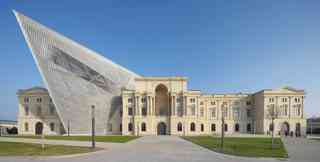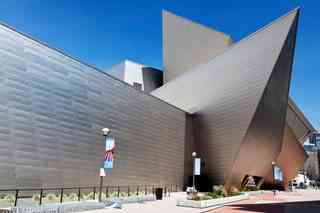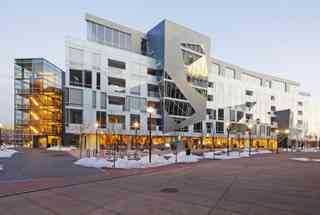
The son of Polish Jews and Holocaust survivors, Daniel Libeskind has dedicated much of his illustrious career to commemorating his heritage through visually dynamic buildings, often with a striking angularity that seems to defy gravity. He founded his firm, Studio Libeskind, in 1989 with his wife, Nina, as the principal architect, and achieved international fame with his addition to the Jewish Museum Berlin, which opened to the public in 2001. His work is often described as Deconstructivist, a style of postmodern architecture characterized by fragmentation and distortion, seen in his design for the U.K.’s Imperial War Museum North with its three intersecting parts inspired by shards of a broken globe. In addition to buildings, Libeskind has also applied his visionary aesthetic to large-scale sculptures, furniture, and interior fixtures. Here, Architectural Digest presents a selection of his best-known and most poignant contributions to the field of architecture.
Dresden, Germany, is home to the Bundeswehr Military History Museum, a classical building that is visually bisected by Libeskind’s 2011 addition. The breathtaking glass-and-steel exhibition space includes a viewing platform at its peak that provides panoramic views of the city.

Inspired by the craggy peaks of the Rocky Mountains, the Frederic C. Hamilton Building at the Denver Art Museum is an extension of the institution’s original building by Gio Ponti in 1971. The titanium-clad structure, which opened in 2006, houses the museum’s Oceanic and African art, as well as its Modern and Contemporary collection.

Directly facing the Denver Art Museum addition is another Libeskind design—a seven-story building with luxury condos called the Museum Residences. The metal-and-glass structure, with its sharp, geometric façade that complements the Hamilton Building, wraps around the complex’s parking garage on one side and provides views of the city on the other.
Completed in 2010, the Bord Gáis Energy Theatre in Dublin is an angular glass-and-steel structure that houses a 2,000-seat performing arts center. The building is part of the Grand Canal Commercial Complex, a plaza designed by Libeskind and flanked by two more of his projects, a five-star hotel and an office building.
Zigzagging across the grounds of the Jewish Museum Berlin is Libeskind’s 2001 addition, a striking contrast to the institution’s original building, which was built in 1735. Clad in sheets of a titanium-zinc alloy, the addition is accessible only through an underground tunnel, and the seemingly random cutouts in the structure’s skin are based on an old map of Berlin.
Named the Michael Lee-Chin Crystal, this steel-clad addition to the Royal Ontario Museum in Toronto was completed in 2007. The stunning structure contains exhibition space, an atrium that serves as a visitor entrance, a gift shop, and three restaurants within its crystalline form. Studio Libeskind also renovated an additional ten galleries in the museum’s old building as part of this project.
Designed with embossed stainless-steel panels that appear to animate the building’s façade, the London Metropolitan University Graduate Centre houses space for lectures, offices, and a café. The building, completed in 2004, features windows that create an arresting visual dynamic with the exterior’s own geometry and the overall silhouette of the structure.
Meant to mimic the fragments of a shattered globe, the U.K.’s Imperial War Museum North, completed in Manchester in 2001, is devoted to exhibits that examine how war has affected the lives of British citizens since 1914. The three “shards” of the building, all clad in aluminum, symbolize earth, air, and water, each housing a different wing of the museum.
Completed in 2008 at the Contemporary Jewish Museum in downtown San Francisco, a geometric form clad in blue steel juts out of a brick building that used to be a power plant. The steel portion, which contains exhibition, performance, and event spaces, is designed to mimic the Hebrew letters chet and yud , spelling l’chaim or “to life.”
Commissioned by the Hyundai Development Corporation, the façade of Seoul, South Korea’s Tangent Building was completed in 2005 to connect the structure to a public plaza. Libeskind designed the façade with a graphically bold mix of balconies and louvers, as well as an angled vector that emerges from the ground and appears to slice through the building.
The Vanke Pavilion in Milan was completed in 2015 as a temporary structure with exhibition space for that year’s Expo Milan. Inspired by elements of Chinese food culture, the building forms a gently twisting abstract shape that’s clad in metallic-finish ceramic tiles. After the Expo, the tiles and the building’s steel parts were all recycled.
The Felix Nussbaum Haus in Osnabrück, Germany, is an extension to the city’s Cultural History Museum dedicated to the namesake Jewish artist. Completed in 1998, the wood-and-steel building has an interior designed with abrupt intersections, confined spaces, and dead ends, all evoking Nussbaum’s persecution during WWII.
Dubbed Eighteen Turns, Libeskind’s Serpentine Gallery Pavilion opened in the summer of 2001 with an origami-like design covered in sheets of aluminum to mirror the surrounding landscape. The temporary structure, located on the London gallery’s lawn, provided space for lectures, parties, and a café beneath its angular, overlapping segments.
Due for completion this year, the L Tower in Toronto cuts a striking figure that gently bows out before tapering at the very top. The skyscraper, clad in gleaming glass with blue mullions, houses almost 600 condos and sits adjacent to the city’s iconic Sony Centre for the Performing Arts, connected by a public plaza. The 58-story building also features inset balconies for sweeping city views.

Leave a Reply